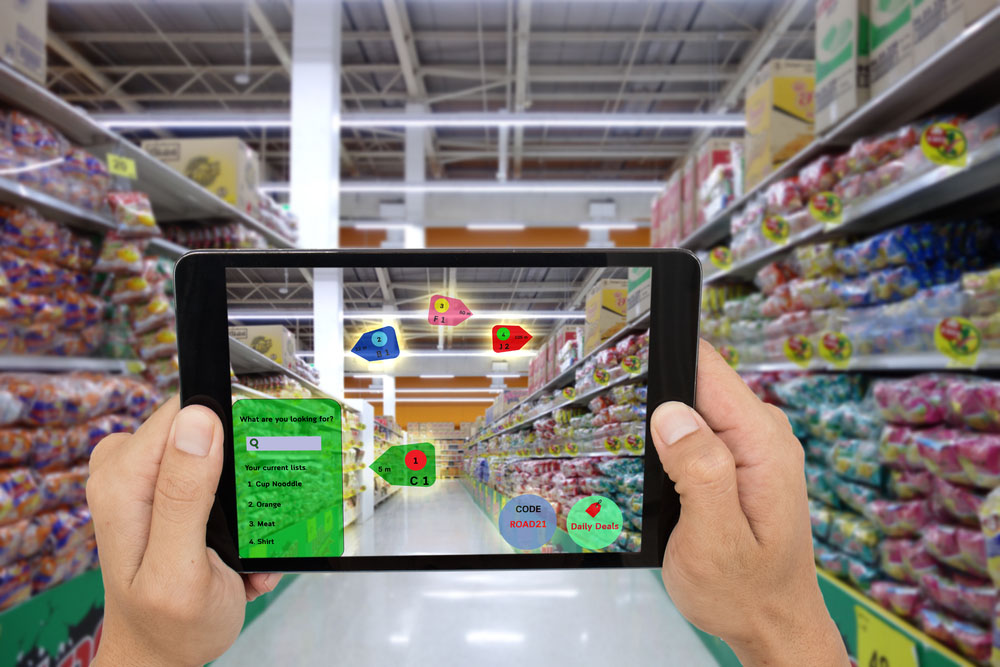The AI-Enhanced Shopping Experience
Investors and retailers are betting that the more pleasant and personalized the shopping experience, the more likely the consumer will buy. And that is what merchants and investors want—happy shoppers busily buying—keeping those goods and services flowing.
FINDMINE’s “Complete the Look” technology creates complete outfits around each product purchased resolving any uncertainty about “How do I wear this?”
Enter artificial intelligence (AI). Investors are already betting big on AI startups, $4.9 billion in 2016. This year, a good chunk of investment is going towards startup technology to make shopping easier and more personal for the consumer and more profitable for the merchant.
Developers are creating smart technologies to both enhance the shopping experience and optimize the supply chain to give shoppers what they want when they want it.
These technologies employ AI to do things like data mining that combines data collected from transactions across all channels (desktop, mobile, email, etc.) with consumer activity throughout the day (think web surfing and Facebook posting) to create a rich profile of the customer. This profile enables an e-commerce merchant to send a highly personalized ad directly related to an AI predicted want or need. The ad arrives in real-time via the social media platform the customer is engaged in. The AI learns more about the consumer with every purchase, perfecting the profile.
Other technologies are using machine learning and natural language processing (NLP) to improve search engine capabilities. The enhanced search capabilities make it both easier for shoppers to find what they want and for the retailer to offer alternatives. As a consumer searches for products or services, the AI learns how the individual communicates—what words he or she uses—and adapts to provide more relevant results.
For brick and mortar stores and warehouses, AI startups are providing technology to streamline the supply chain for the merchant and optimize product placement for suppliers.
Recent AI Startups Personalize the Shopping Experience
For both online and brick and mortar stores, AI startups are developing technology to personalize the shopping experience. As the consumer shops online, the personal assistant delves into its trove of information in real-time to offer exclusive personalized offers that appeal to the shopper’s tastes and preferences.
The startup company Mona has created a personal shopping assistant in the form of a smartphone app. Mona serves a database of over 300 retailers. As you shop the Mona platform, she learns your style taste, brand preferences, and price point. Mona searches among the retailers in her system to offer you the best price or promotion.
Two startups offering real-time product targeting are Dynamic Yield and Reflektion. Reflektion provides a neat twist by allowing the shopper to attach a photo to any search query. The photo combined with natural language processing instantly provides more accurate results, reducing the amount of time it takes for the customer to find what he or she wants. And lessening the chance the shopper will move on to another site.
ViSenze is a startup company that also employs visual search technology. A shopper can take a photo of an item in a retailer’s store and search the retailer’s online stock to shop for similar items. The engine provides alternatives for out of stock items to induce a sale.
Machine learning enables real-time pricing and incentives, wherein shoppers are motivated to buy through real-time price adjustments, reward offers, and alternative buying options. The startup Granify provides an online retailer with a platform that monitors over 400 attributes per second to predict the customer’s next move as the shopper searches the retailer’s website. Should the AI sense hesitation (interpreted as an objection), the system will provide a message or incentive to overcome the objection to and trigger a purchase.
AddStructure is a startup using natural language processing to improve and personalize e-commerce searches. AddStructure addresses three levels of a search—first finding the merchant’s website, then finding the product on the site, and lastly, finding the most relevant product on the website for that particular shopper. From the original search query (on Google or Firefox), AddStructure’s engine cross checks the search query with the merchant’s inventory data and the consumer’s profile to generate a personalized landing page for the searcher.
In an article in the January issue of Stores Magazine, William Underwood, AddStructures co-founder, stated, “We want shoppers to be able to go to an app or a website and say what they’re looking for. Our technology understands their priorities and delivers the best possible results — making it quick and frictionless to transact.”
Other startups such as FINDMINE focus on sizing and styling to offer products to build a consumer’s wardrobe while increasing the merchant’s sales. FINDMINE’s “Complete the Look” technology creates complete outfits around each product purchased resolving any uncertainty about “How do I wear this?”
Many of the startups use AI in multi-channel marketing — creating targeted marketing campaigns across desktop, mobile, email, and other digital channels. For example, Thirdshelf enables retailers to quickly create and send a personalized email or SMS offer to entice customers back into the store to add to a recent purchase. This solution also provides the retailer with reports on the sales impact of offers and loyalty programs.
The Brick and Mortar Dilemma
Almost daily we read about the demise or soon demise of some iconic retail store (think Sears or Kmart). To remain competitive, brick and mortar retailers are going to have to embrace technology to attract and retain customers.
In a recent report issued by Springboard Retail, survey results from 400 customers revealed information critical to retail survival: 70% of shoppers would revisit a store because of personalized experiences. 71% would rather go online to avoid in-store delays and hassles. 75% of buyers want to know what’s in stock before entering a store.
Startup companies are coming to the rescue. Companies like Plexure are using both digital and physical store analytics to help retailers better understand their customers. Plexure’s CRM platform enables marketers to connect brands with consumers while the shoppers are in the store, in real-time.
Manthan winner of the 2017 Amazon Web Services Innovation Partner of the Year Award, uses customer analytics and Amazon Alexa and Lex technologies to provide personalized interactions based on customer behavior.
Another useful tool for retailers integrates digital and physical store analytics with beacon technology to track a shopper’s physical location. Invisible Media uses mobile cloud data and customer physical location information to “create a 360o view of the customer.” In real-time, the decision engine processes multiple data inputs and device signals to discern user interests and predict future purchase. The retailer can hit the customer with a customized message or offer at just the right time on the right channel.
Recent Startups Optimize Retail Inventory and Pricing
AI startups are employing in-store visual monitoring, robots, and analytics to streamline the supply chain and optimize product placement, as well. New technologies predict customer behavior, supply stores with in-demand items, eliminate slow-moving stock, and provide better pricing strategies, to maximize retail sales and profit.
COSY provides smart software and in-store visual monitoring for brick and mortar stores to optimize inventory management for brick and mortar stores. COSY’s SCOUT technology platform uses artificial intelligence, machine vision, and robots to streamline the stocking process Robots survey retail store floors to keep an accurate stock count. Accurate counts and visuals help minimize stock-outs and maintain intended product placement to promote increased sales. Suppliers use real-time analysis of photo and visual content of the store shelves to track how their products are stocked and promoted.
Investors are betting that Blue Yonder, a German Big Data platform, has the AI solution to provide retailers with predictive merchandising and price optimization. Analyzing vast accumulations of data from multiple sources, including data on customer demographics, weather, inventory levels, product characteristics and demand, competition, and competitor pricing, Blue Yonder optimizes purchasing, stocking, pricing, and product offerings across stores and e-commerce.
Whether online or in-store, thanks to highly personalized targeted marketing, shoppers are in for a 360o, potentially 24-hour shopping immersion. It’s difficult to fully comprehend the bold impact AI will have on our already highly consumerized society as new technologies grow.










